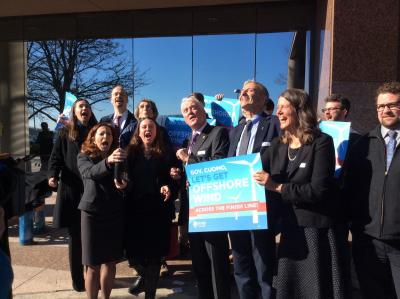LIPA Okays South Fork Wind Farm

The Champagne began to flow at 12:45 Wednesday afternoon, moments after the Long Island Power Authority's board of directors voted unanimously to approve a proposal for a 15-turbine, 90-megawatt South Fork Wind Farm in federally leased waters 30 miles off Montauk. The formal approval of the installation, which is expected to be operational by December 2022, comes just one month after the five-turbine, 30-megawatt Block Island Wind Farm, the nation's first such offshore facility, went online.
Jeffrey Grybowski, the chief executive officer of Deepwater Wind, which built the Block Island Wind Farm and proposed the South Fork Wind Farm to LIPA, told The Star Wednesday that LIPA had authorized its chief executive officer, Thomas Falcone, to ink a 20-year contract to buy the energy generated by the wind farm from his company. The agreement, which includes a five-year extension option, is expected to produce energy sufficient to power more than 50,000 residences.
"This is a big day for clean energy in New York and our nation," Mr. Grybowski said later in a press release. "Governor Cuomo has set a bold vision for a clean-energy future, and this project is a significant step toward making that a reality. . . . There is a huge clean-energy resource blowing off of our coastline just over the horizon, and it is time to tap into this unlimited resource to power our communities."
The wind farm will be connected to an East Hampton substation via a cable. "We are in the process now of exploring options, but have not settled on a land location or route," Mr. Grybowski said Wednesday. "That is something we need to work with the town and community on."
The vote came two weeks after the governor, in a regional State of the State address delivered at Farmingdale State College, called on LIPA to approve the wind farm, and announced a commitment to develop up to 2.4 gigawatts of offshore wind by 2030. The 2.4-gigawatt target, which could power 1.25 million residences, is to date the largest commitment to offshore wind energy in the United States.
Wednesday's vote came six months after LIPA postponed an expected approval of the project at the behest of the New York State Energy Research and Development Authority, which had asked the authority's board of directors to delay a vote so the wind farm could be examined in the broader context of its Offshore Wind Master Plan. A draft blueprint of the master plan, which is expected by the end this year, was released in September.
"This was the least-cost option for meeting the South Fork's energy needs and peak demand needs, as well as their renewable-energy needs," Gordian Raacke, executive director of East Hampton-based Renewable Energy Long Island, who attended Wednesday's meeting, said of LIPA. "Amongst the 25 proposals that they reviewed in combination with each other and various packages, this was the most cost-effective."
The proposal includes two battery-storage facilities, which were discussed Wednesday but require local approval before their inclusion can be confirmed. The wind farm will be able to deliver power without those storage facilities, "but of course, wind, as with some other renewable sources, is intermittent by nature," Mr. Raacke said. Those facilities "would help smooth out those times when there isn't as much wind" and are important, he said, "because we will have a shortfall in capacity this summer and in summer 2018. My hope is that approvals for the battery storage will come on time to still have that operational before summer 2018."
Demand for electricity on the South Fork has outpaced the rest of Long Island, with particularly high usage in the summer and on weekends and holidays. Electricity demand has also vastly outpaced population growth, with the megawatt peak growing by 44 percent while residential accounts grew by just 4 percent and commercial accounts by 12.3 percent over a decade, according to statistics issued in 2015 by PSEG Long Island, which manages the island's electrical grid on behalf of LIPA.
"When we looked at the options and alternatives to meet the growing need in East Hampton and Southampton, it turns out this is the lowest-cost proposal," Mr. Falcone said of the South Fork Wind Farm in July. "It makes sense to bring this generation in while also meeting some renewable energy goals our board has established. It's not just good for East Hampton and Southampton, it's good for everybody on Long Island, a very good place to deliver the energy."
The commercial fishing industry is opposed to offshore wind installations, its representatives citing disruption to habitat and the potential to alter migratory patterns. Mr. Grybowski said Wednesday that he hoped to allay those concerns. "We are absolutely committed to working very closely with the commercial fishing industry," he said. "We have already sent a representative to Montauk a number of times to meet with fishermen. We will continue to do that in the coming months and years. We are convinced that offshore wind and commercial fishing will co-exist in the ocean."
Deepwater Wind, a Rhode Island company, has proposed an additional 210-megawatt installation in the same lease area in which the just-approved wind farm will be situated, Mr. Grybowski said Wednesday.
Mr. Raacke, a member of East Hampton Town's energy sustainability advisory committee, noted that Mr. Falcone had said Wednesday that "this will not be last offshore wind project."
"This really is, I think, a historic moment and will be remembered as the point when Long Island made the switch from fossil fuels to clean, renewable, and local power sources," Mr. Raacke said.
